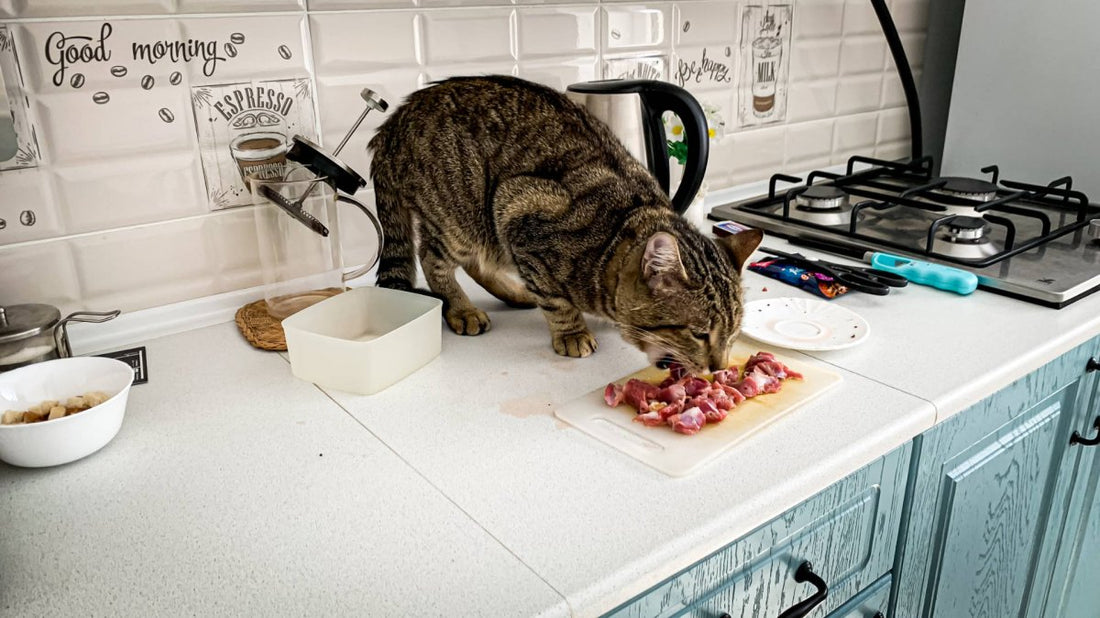BARF for cats: trend or species-appropriate nutrition?
A healthy diet for our cats is our top priority. Perhaps you've heard of raw feeding for cats , but are unsure if it's the right feeding method for your pet? Raw feeding—that is, feeding organic, species-appropriate raw food —has become a viable alternative for many cat owners. But what's behind it? Let's explain step by step how you can raw feed your cat, which recipes are suitable, and why it's worth trying.
What does raw feeding mean for cats? An overview
The term BARF stands for "Biologically Appropriate Raw Food . " BARF is about mimicking a cat's natural diet—feeding raw meat, bones, offal, and essential supplements.
The basic idea of BARF:
- Cats are carnivores .
- In nature they eat prey such as mice or birds.
- A natural diet consists of raw meat , supplemented with important nutrients such as vitamins and minerals.
What should be included in a BARF menu for cats?
- Raw muscle meat – e.g. chicken, beef or turkey.
- Offal – liver, heart, kidneys for important vitamins.
- Bone or bone meal – source of calcium for strong bones.
- Animal fat – provides important energy.
- Supplements – Taurine, fish oil, vitamin supplements to avoid deficiencies.
The benefits of raw feeding for your cat
Barfing has many benefits, provided it is done correctly.
1. Healthy and natural nutrition
- BARF is based on the cat’s original diet.
- No artificial additives or inferior fillers.
2. Better health
- More beautiful coat : The skin becomes healthier and the coat shines.
- Fewer dental problems : Chewing raw meat strengthens the teeth.
- More stable immune system : A balanced diet supports the immune system.
3. Fewer digestive problems
- Many cats tolerate raw food better than prepared food.
- The stool becomes smaller and smells less unpleasant.
4. Individual customization
- You determine the ingredients and can react specifically to intolerances.
Barfing Cat: How to put together the right menu
The key to raw feeding is balance . A good raw feeding menu consists of various components that cover all nutrients.
The perfect BARF blueprint for cats:
-
Muscle meat (80–85%):
- Chicken, beef, turkey, rabbit or duck.
-
Offal (5–10%):
- Liver, heart, kidney – important for vitamins such as A and B.
-
Source of calcium (5–10%):
- Raw meat bones, eggshell powder or bone meal.
-
Fats (5–10%):
- Animal fats such as fish oil or goose fat.
-
Additions:
- Taurine, vitamin E, salmon oil and minerals.
Cat raw feeding recipe: Simple examples to copy
Are you new to raw feeding and need simple recipes? No problem! Here are two BARF recipes you can try.
Recipe 1: Chicken & Offal Menu
- 300 g chicken (raw, cut into pieces)
- 50 g chicken heart
- 20 g chicken liver
- 1 tsp bone meal
- 1 tsp salmon oil
- 500 mg taurine
- 1 pinch of salt
Preparation:
Mix all ingredients well and freeze in portions. Thaw before serving.
Recipe 2: Beef & Salmon Treats
- 200 g beef (lean, cut into pieces)
- 50 g beef liver
- 1 tsp ground eggshell
- 1 tsp goose fat
- 50 g raw salmon (chopped)
- 500 mg taurine
Preparation:
Mix the ingredients and ensure even distribution. Feed small portions fresh or freeze them.
BARF mistakes you should avoid
BARF offers many benefits, but mistakes can easily occur. Here are the most common pitfalls:
-
Inadequate nutrient supply:
- Taurine, calcium, and vitamins are essential. Supplement selectively.
-
Fake meat:
- Avoid pork as it can transmit disease.
-
Irregular variety:
- Use different types of meat to ensure nutritional diversity.
-
No check-up at the vet:
- Have your cat’s blood values checked regularly.
Is raw feeding really better than ready-made food?
The question of "barfing or ready-made food" is a controversial one. Both methods have advantages and disadvantages:
Barfing advantages:
- Full control over the ingredients.
- No artificial additives.
- Natural nutrition.
Barfing Disadvantages:
- Time required for preparation.
- Risk of nutrient deficiencies if incorrectly composed.
Frequently asked questions about raw feeding for cats
“Can every cat be fed raw food?”
Generally yes, but if your cat is sick or old you should consult your vet.
“How do I start raw feeding?”
Start slowly with small portions and gradually mix in the raw food.
“How often do I have to feed the cat raw food?”
Feed 2-3 meals a day, depending on your cat's age and activity level.
Conclusion: Barfing your cat – a healthy alternative to ready-made food
Raw feeding provides your cat with a species-appropriate and healthy diet, but requires some knowledge and preparation. In summary:
- Barfing a cat means feeding raw meat, offal and supplements.
- It offers many benefits: healthier coat, better digestion and more energy.
- Make sure your cat gets balanced nutrients and has them checked regularly.
With the right recipes, a little patience, and knowledge, raw feeding your cat will enrich their life. Your furry friend will thank you – with purring well-being and pure joy! 🐾



